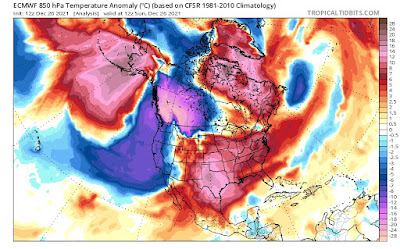 |
Photo looks a bit like April in Vermont, but it was a
springlike Frederick, Maryland on Sunday, where
temperatures were in the upper 50s under bright
blue skies. Maryland was on the edge of
some record heat engulfing the southern U.S |
In the grand scheme of things, the weather in Vermont this week is kind of boring. The Christmas Day ice notwithstanding, the rest of this week will feature temperatures not incredibly far from normal, and any oncoming bits of snow or rain or mix don't look too far off into bizarro world.
Vermont's "boring" weather this week is a big exception to a national rule. I'm writing this from my temporary perch, for today in Frederick, Maryland.
Yesterday, Boxing Day was a gorgeous spring day here in Maryland.. Plenty of sunshine, temperatures well up into the 50s, the day after it was in the 60s. In Frederick, I saw a bush on one street here with lovely new pink blossoms, buzzing with bees.
Normally this time of year, it's barely 40 degrees during the day.
Frederick, Maryland was not even close to the most extreme weather the nation has been seeing the past few days.
Hot, frigid, stormy, fiery, windy, snowy, icy, you name it. It's there. We have some huge contrasts going on in the nation as we close out the year 2021.
Let's start with heat, since it covers such a big chunk of the nation.
On Christmas Eve, Wichita Falls, in northern Texas reached 91 degrees, that city's hottest December reading on record.
Video from Live Storm Media showed strong winds causing minor structural damage and filling the air with thick dust around Amarillo, Texas. Winds there gusted to at least 56 mph on Christmas Eve.
Record highs continued in Texas on Christmas Day and yesterday. This heat was punctuated by a new round of odd winter wildfires that extended on up into eastern Colorado. Most of Colorado should be a chilly snowscape this time of year. At least Colorado's mountains and ski areas managed to get some snow Sunday.
On Christmas Day, record high temperatures were spread far and wide. Records included 86 degrees in Abilene, Texas, 67 in Cincinnati, 74 in Paducah, Kentucky, and 72 in Evansville, Indiana.
In Rio Grande Village, Texas on Christmas Day, it was reportedly 96 degrees. If that reading is verified, it will be the record for the hottest Christmas Day on record anywhere in the Lower 48.
Down in Houston, it's been in the 80s thirteen times so far this month, and each of the closing days of this month should also reach 80 degrees there. This will easily be that city's hottest December on record. Normal highs in Houston this time of year are in the low to mid 60s.
It's not just Houston. After four record December heat waves in the Midwest and South, many cities in the United States look assured of having their warmest December on record.
This is in huge contrast to the Pacific Northwest and British Columbia, which are in the grips of a pretty intense - at least for them - spell of winter weather.
In a rare moment for the region. the field had to be cleared for a Seattle Seahawks Sunday to prepare for a game with the Chicago Bears. At least the Bears should have been ready for winter conditions. They did manage to squeak out a 25-24 win over the Seahawks.
In California, snowfall in recent days measured in feet, not inches. Many roads through the Sierra Nevada range, including Interstate 80, had to close due to the deep snow. Donner Pass has had 119 inches of snow so far this month. The record for December there is 179 inches. It's supposed to keep snowing there for the next couple of days, so that record could be challenged.
The Sierra snow is mostly good news, though, because until mid-month, snow cover was well below normal there. Now, it's a little above normal, which could help dent California's drought.
Those winter storms and cold are extending as far east as Lake Superior in the northern tier of states. Blizzard warnings are up for North Dakota today. Though temperatures are well below normal from Washington to Minnesota, there aren't that many record low temperature records being set. Not nearly as many as the heat records further south and east, anyway.
Some of this cold air in the Northwest will be on the move to the east, which could easily cause another round of dangerous weather in the South.
The unseasonable, record heat in the South, combined with rising humidity, risks causing another outbreak of severe storms and tornadoes in the upcoming week. The cold air approaching might well be the spark that sets off those storms on Wednesday. Another round of severe storms seems possible New Years Day before the cold air finally takes over.
This in a December that has already broken the record for the most tornadoes for the month.
The weirdness extends up into Alaska. At one point Sunday Tanana, in normally frigid central Alaska reported freezing rain with a temperature of 8 degrees. I don't think I've ever seen rain fall at such a low temperature.
For us Vermonters, the Green Mountain State seems to be escaping most if not all of the nation's weather drama. Several small disturbances will zip on by this week.
As the warm weather pattern in the South and Southeast breaks down this weekend and early next week, that might spin up a fairly substantial storm that could give Vermont a pretty good dose of snow rain or schmutz by Sunday and Monday.


















